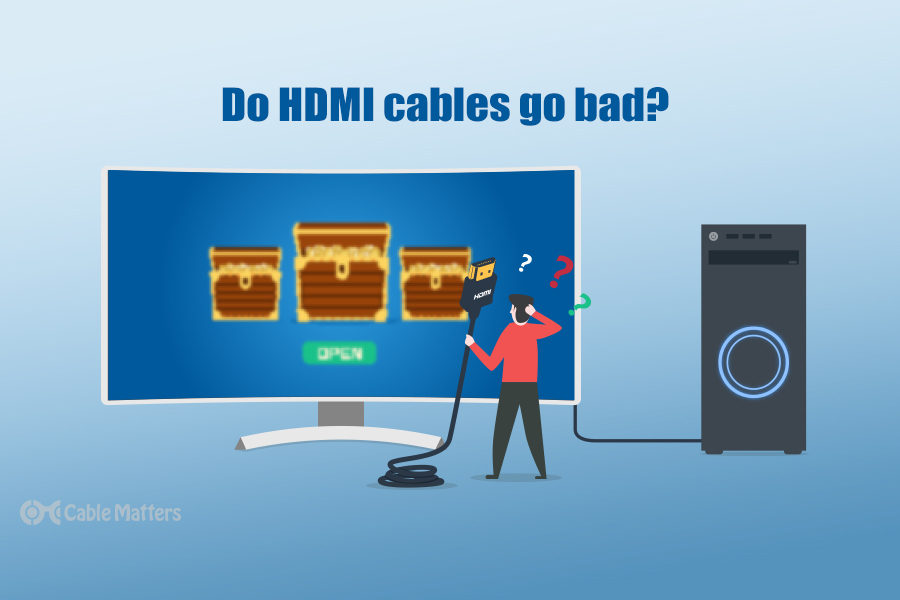
Sometimes it seems like no technology lasts as long as it should. Your phone feels sluggish after a couple of years, your laptop just isn't as snappy as it once was, and your TV doesn't have that exciting feature that all the new ones do. Even cables change with the times and new standards are released to take advantage of the ever onwards advance of technology.
At least you can rely on the ones you have to not go wrong after a few years, right?
Do HDMI cables go bad?
Cables, especially ones of high-quality like the ones Cable Matters sells should not simply go bad, as long as you treat them well. There is nothing about a cable which inherently means it will break down. They aren't typically exposed to dangerous elements, corrosive materials, or strenuous wear and tear. If you set your cables up behind your TV, or routed around the edge of a carpet, or even through your walls, there is no reason to think your HDMI cable will go bad.
This wouldn't necessarily be the case if cables were simply shipped out with raw copper wiring. The reason cables like HDMI are so durable is because they are designed to be. They feature individual insulation for each of the copper wires, followed by a foil shield around each of those. The entire collection of internal wires is then wrapped in a protective layer of braided shielding, followed by the exterior flexible plastic layer that you are most familiar with.
You don't even need to worry about the connector going bad over time as Cable Matters HDMI cables are all gold plated on the connector to add extra corrosion resistance.
So, do HDMI cables go bad? Not by themselves.
But you may need to replace them eventually
The one caveat to all this is that while HDMI cables don't simply go bad over time– they may need to be replaced one day. There are physical damage reasons that that might happen, such as extreme force shearing the cable in two, or damaging the internal wiring. Extreme wear and tear in certain environments can also lead to soldering wearing out, wires coming loose, or the header detaching from the main cable body.
Cable Matters takes steps to avoid this, with sturdy cable structures, multiple shielding technologies, and gold plating on the header to protect against corrosion. But there's no denying that if a cable is treated poorly, or just exposed to above-average environmental stress, it can become damaged over time.
You'd notice rather quickly if this happened, though, because you'll see frequent disconnection errors, even if the cable is plugged in, and in some cases, the image quality will degrade. If your cable just stops working entirely, then that's a pretty good sign that it's been damaged somehow. Even if the damage is not visible, there is a good chance some of the internal copper wires have become loose or a soldering joint has worn off.
Do HDMI cables go bad? They may eventually but you can extend their life greatly by looking after them. But even then, there is always the possibility that new technologies will come along, encouraging you to upgrade.
Typically most cable standards are intergenerationally compatible, which means they support both forward and backwards standards. A DisplayPort cable that was bought with a first-generation device will still work today with a device that supports DisplayPort 1.4, or 2.0. But that's not the case with some HDMI cables.
HDMI cables can grow old too
HDMI cables have gone through a number of generational upgrades since their inception in 2002. Version 1.0 became 1.1, then 1.2, and 1.3, and so on. Throughout that time the cables haven't changed much, with each generation being backwards compatible with everything else, no matter how long they are. That's still true today, but there is a rather large caveat with HDMI 2.1.
Like the generations of HDMI cable that came before them, HDMI 2.1 improves the overall bandwidth of the HDMI connection considerably, giving it support for much higher resolutions and refresh rates, as well as new important technologies like display stream compression (DSC), high dynamic range (HDR), and dynamic refresh rates.
But where previous generations of HDMI cables didn't require any physical changes to take advantage of these advancements, the HDMI 2.1 standard does. HDMI 2.1 cables can support Ultra High Speed, which is what allows the greater-than-ever-before bandwidth capabilities of HDMI 2.1 and without it, you cannot take advantage of it.
While older HDMI cables will work just fine with HDMI 2.1-supporting devices, they cannot enjoy the added bandwidth of HDMI 2.1 and therefore are not fit for the task of delivering some of the promises HDMI 2.1 makes. HDMI 2.1 cables, on the other hand, are entirely backwards compatible, so while you may need to upgrade your cables to make the most of your new devices, you can use those cables on any of your other HDMI devices if you so choose.
So, if you're not having luck with your new HDMI 2.1 enabled devices with your old HDMI cables, the question isn't, "do HDMI cables go bad?", it's "are my old HDMI cables obsolete?"
Buying HDMI 2.1? Look out for these features
All HDMI 2.1 cables support the new, higher-bandwidth of the standard, but if you're looking to upgrade your cables or buy a new one for a new device, you'll want to make sure you're getting the right one. Some cables are sold as 8k ready or with a rating of 48Gbps. Those are both different ways of saying they are HDMI 2.1 cables, as no HDMI cables can effectively handle those kinds of resolutions or bandwidth but HDMI 2.1.